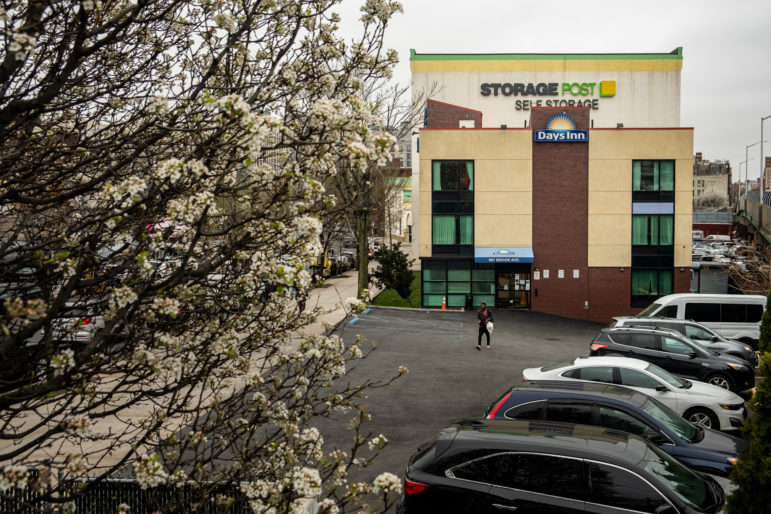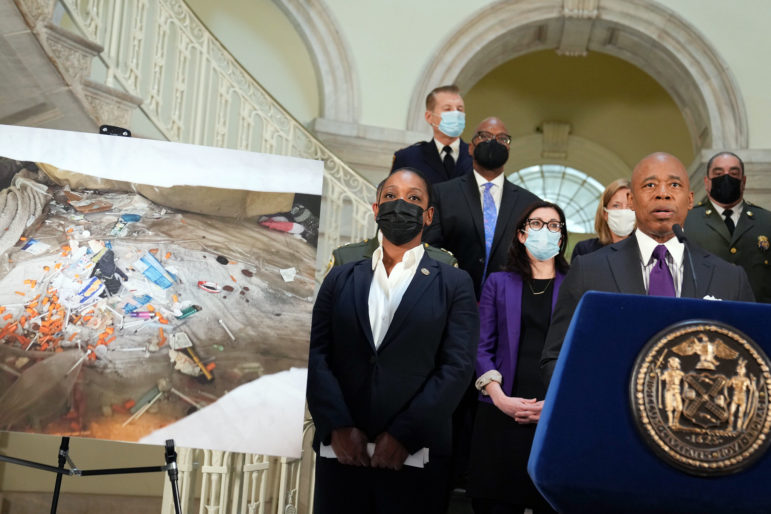The site opened to people moving off the streets and subways on March 28, amid significant backlash to ongoing homeless sweeps and calls by advocates and some elected officials for the city to use hotel rooms as low-barrier, private spaces for people bedding down outdoors.

Adi Talwar
The hotel is intended to serve as a sort of way station between the streets and other shelter settings. City officials say they plan to open similar sites elsewhere in the five boroughs.Inside the lobby of a Bronx hotel-turned-shelter last Thursday, a man named Marco sat smiling with a remote control in his hand.
Marco had arrived two days earlier, he said, after spending the past several months at a friend’s house, the Department of Homeless Services’ (DHS) 30th Street intake shelter and on the streets. He said police brought him to the hotel in Morrisania when he asked for help because he did not want to stay in a large, congregate facility.
He had had a pleasant experience so far and enjoyed watching television in the room he shared with one other person. “I’m not outside, thank God,” he said as rain poured outside.
The hotel, long used as a shelter for New Yorkers experiencing homelessness, was abruptly converted into a so-called “Welcome Center” for unsheltered New Yorkers by DHS and the nonprofit Acacia in late March. The facility seems to signify a somewhat different approach to addressing street homelessness for Mayor Eric Adams as he continues to prioritize sweeps of outdoor encampments and subway cars, with police cracking down on people who refuse to leave.
The Bronx location functions as a “pre-assessment” site with 84 short-term beds for people who agree to move out of public spaces, DHS said. The hotel is intended to serve as a sort of way station between the streets and other shelter settings, like Safe Havens and stabilization rooms, DHS officials added. The goal is to cycle people into those other settings after a few weeks.
“This program exemplifies this Administration’s commitment to continuing to find creative ways to encourage New Yorkers experiencing unsheltered homelessness to come in off the streets and subways and take the first step back on to the path to stability,” an agency spokesperson told City Limits in a statement.
The facility is designated as a stabilization site, a place where street homeless New Yorkers can find accommodations without going through the sprawling shelter system intake process. DHS can categorize stabilization sites as emergency measures and the agency does not have to give community notice before opening one (In contrast, Safe Havens, which have on-site social services that stabilization sites often lack, require public notice that often triggers virulent resistance).
The place is run by the organization Acacia Network, a politically connected nonprofit with limited experience serving street homeless New Yorkers, but with enough clout among South Bronx elected officials to curb resistance to a new site for people experiencing homelessness.
Still, homeless services providers—including the ones who are ostensibly supposed to make referrals—say they know little about the initiative.
The Welcome Center opened to people moving off the streets and subways on March 28, amid significant backlash to ongoing homeless sweeps and calls by advocates and some elected officials for the city to use hotel rooms as low-barrier, private spaces for people bedding down outdoors.

Ed Reed/Mayoral Photography Office
Mayor Eric Adams and other officials at a press conference about addressing street homelessness on March 30.
Three days later, on April 1, DHS held a conference call with street outreach providers to share broad strokes of the new welcome center initiative, according to two people familiar with the conversation.
Three frontline outreach workers interviewed by City Limits over the past week said they did not know the new site existed.
In response to questions from City Limits, DHS said 30 beds at the hotel were occupied last week and individuals must be referred there by an outreach team, meaning they cannot “self check-in.” A man walking away from the building on April 7 stopped to briefly talk with City Limits and said he had tried to secure a room in the building but was turned away.
City officials say they plan to open similar sites elsewhere in the five boroughs, but the “welcome center” designation has confused service groups and advocates.
A flexible facility with semi-private rooms seems like an appealing option for people staying in public spaces, said Coalition for the Homeless Policy Director Jacquelyn Simone. The concept is similar to what many unsheltered New Yorkers and their advocates have been urging the Adams administration to provide until they can access their ultimate goal of permanent housing.
But Simone said she worries that people will be forced to leave after a brief stay and that DHS is not communicating the time constraints with the people who move in. Once someone secures a bed in a hotel room, it is unlikely they will want to leave to stay in another temporary setting, like a group Safe Haven, she said.
“We want to make sure the design of the program and the intent are transparently conveyed to people when they move off the street,” Simone said.
“Being told you have to move is really stressful and disruptive for people,” she added. “I don’t know if sending them to one site for a couple weeks and then transferring them to a new site is the best strategy possible.”
She and other advocates who are typically tuned into DHS policy minutiae say they are in the dark about how exactly the Welcome Center will function. Simply using the space as a stabilization site may be the most helpful way to encourage people to move off the streets, she said.
“It’s unclear what the added benefit of using this facility as a welcome center instead of a stabilization bed facility with private rooms is,” she said.
Craig Hughes, a social worker with the Urban Justice Center’s Safety Net Project, said moving people from one shelter to another can have “acutely traumatizing and destabilizing” effects and recommended that the city allow people to stay in the hotel until they get an apartment.
“Instead of quarter-measures that just lead to another instance of displacement from shelter to shelter to shelter, Mayor Adams should put housing placements—not just shelter placements—for people on the street, front and center,” Hughes said. “The city should offer everyone being placed there the option to stay and quickly place them into permanent housing, not another shelter.”
Most people on the streets have already tried congregate shelters before opting to leave, according to a survey last year by the Coalition for the Homeless. Safe Haven and stabilization sites have fewer restrictions and curfews, but they do not necessarily offer the privacy that many people on the streets say they want.
New York City has begun to add Safe Haven and stabilization capacity in recent weeks as shelters sited under the last mayoral administration begin to open. Adams attended the ribbon-cutting of a new 80-bed shelter near Lincoln Hospital last month, where he pledged to make 350 beds available within a week.
“This facility is an indicator of what’s possible. It’s a safe space with wraparound services,” Adams said. “You can’t get this on the A train overnight. You can’t get this sleeping in Times Square. You can’t get this sleeping in a cardboard box.”
The Safe Haven occupancy rate has increased steadily since the start of the year, according to daily DHS Census data tracked by City Limits. There were 1,395 people staying in Safe Havens on April 12 compared to 1,162 on Jan. 3, the city data shows.
DHS does not consistently report the number of people staying in stabilization beds, but there were 990 available late last month, according to the Coalition for the Homeless.
When City Limits visited the new Welcome Center on April 7, an Acacia employee sat at a small folding table in the lobby with a book for people to sign in, while another staff member was stationed behind the hotel’s concierge desk. The vibe was friendly and residents seemed relaxed.
Next to Marco, the resident holding the remote control, a man read a newspaper while two other people entered the lobby. One appeared to get his blood pressure checked by a staff member.
The front desk worker left briefly to consult with an Acacia administrator who was working at the shelter. The man, an assistant vice president at the organization, declined to answer questions and instead referred all inquiries to DHS.
“I cannot confirm or deny where this location is,” he said while standing in the lobby of the hotel.
Just outside the building, a man named David Harris stopped to discuss his experience as he made his way to a grocery store.
Harris, 42, said he had been sleeping in the subway system for the past two years after his parents died and a family member sold the house where he was living in Brooklyn. He said an outreach worker approached him earlier in the week and asked if he would like to stay in a hotel. The outreach team transported him to the site that day.
“I wanted to try something different,” he said.
He said he had started working with a case manager to access benefits and expected to stay at the hotel until he secured permanent housing.
“I can stay here for a while,” Harris said. “Until I get my own place.”








